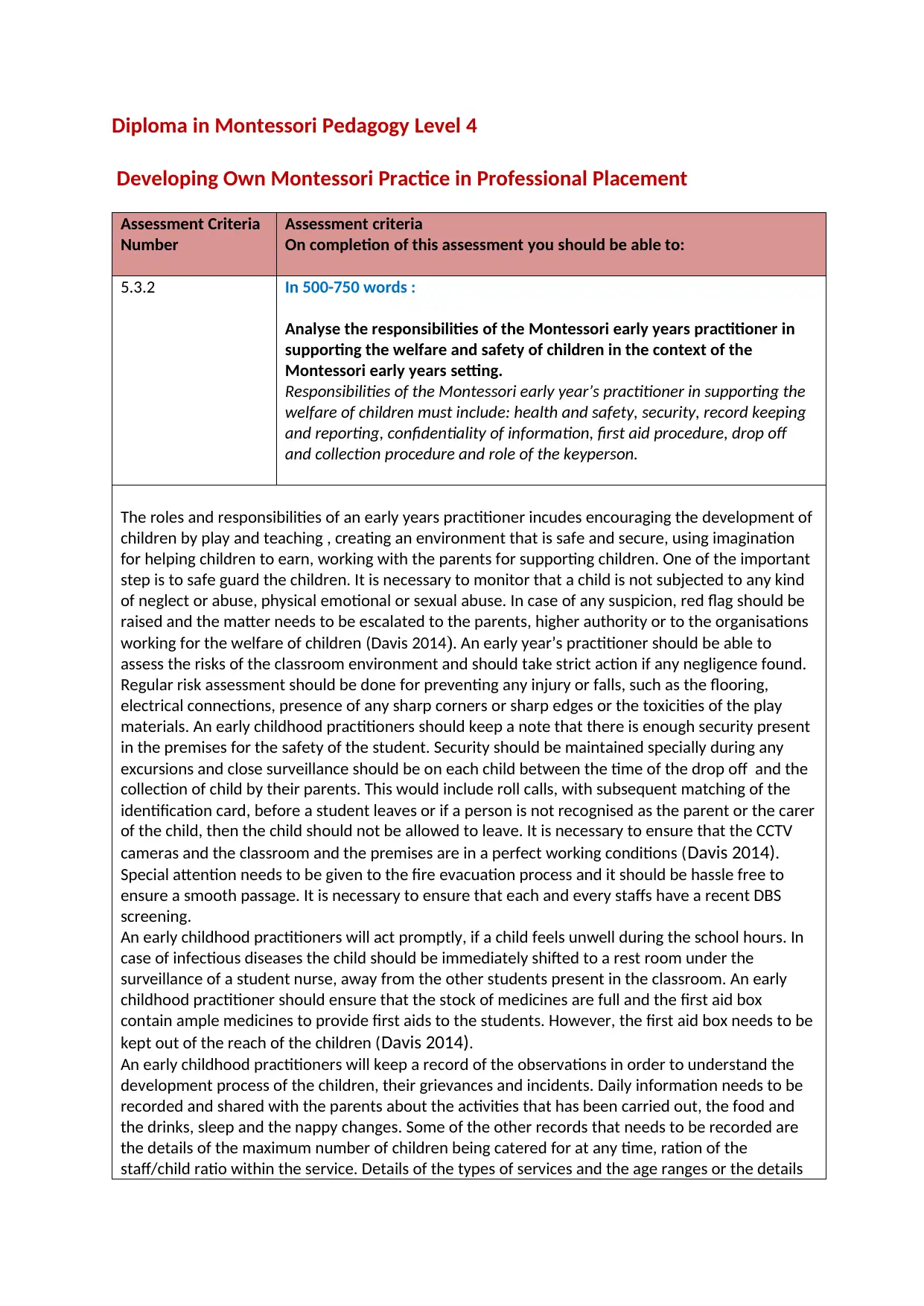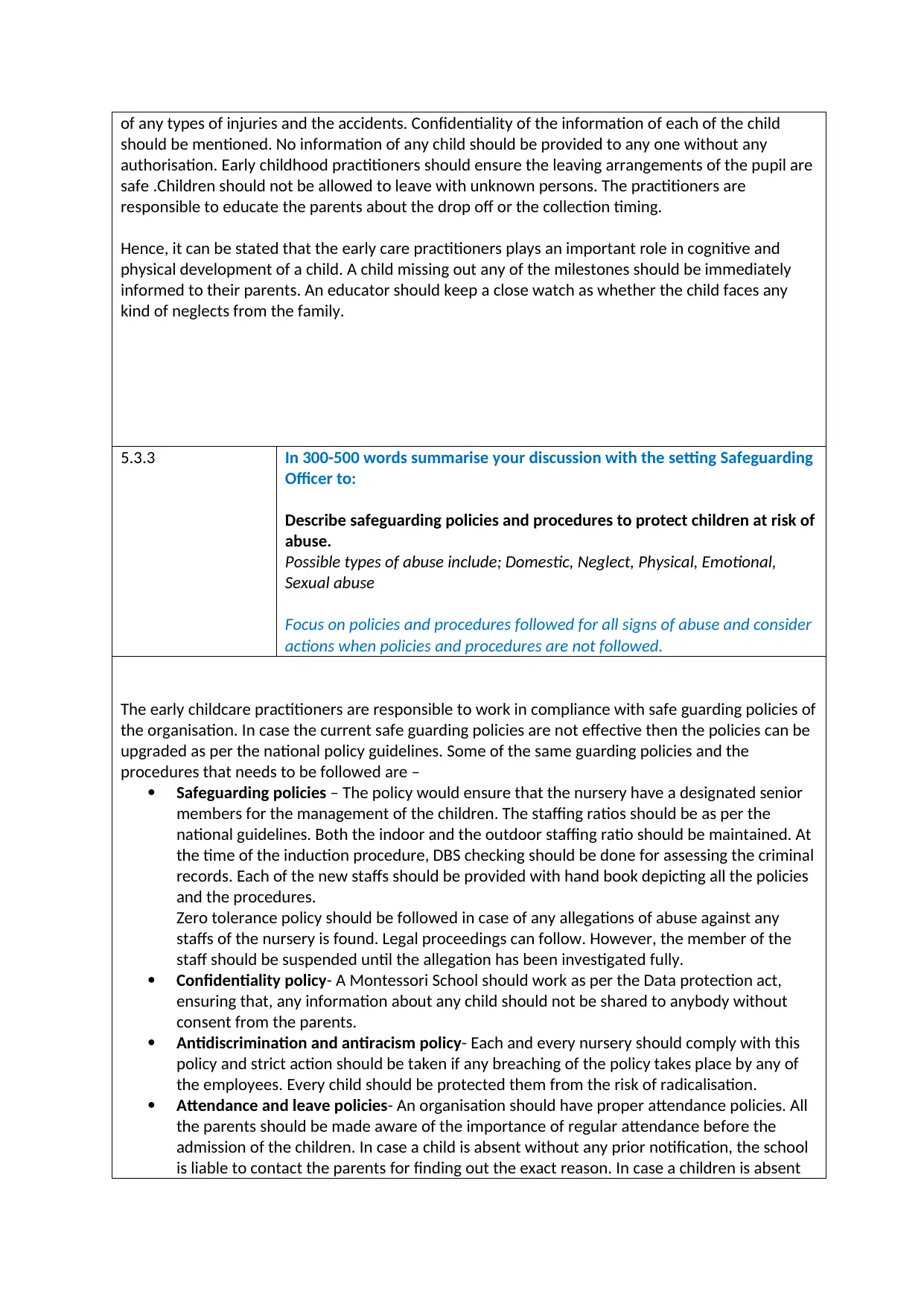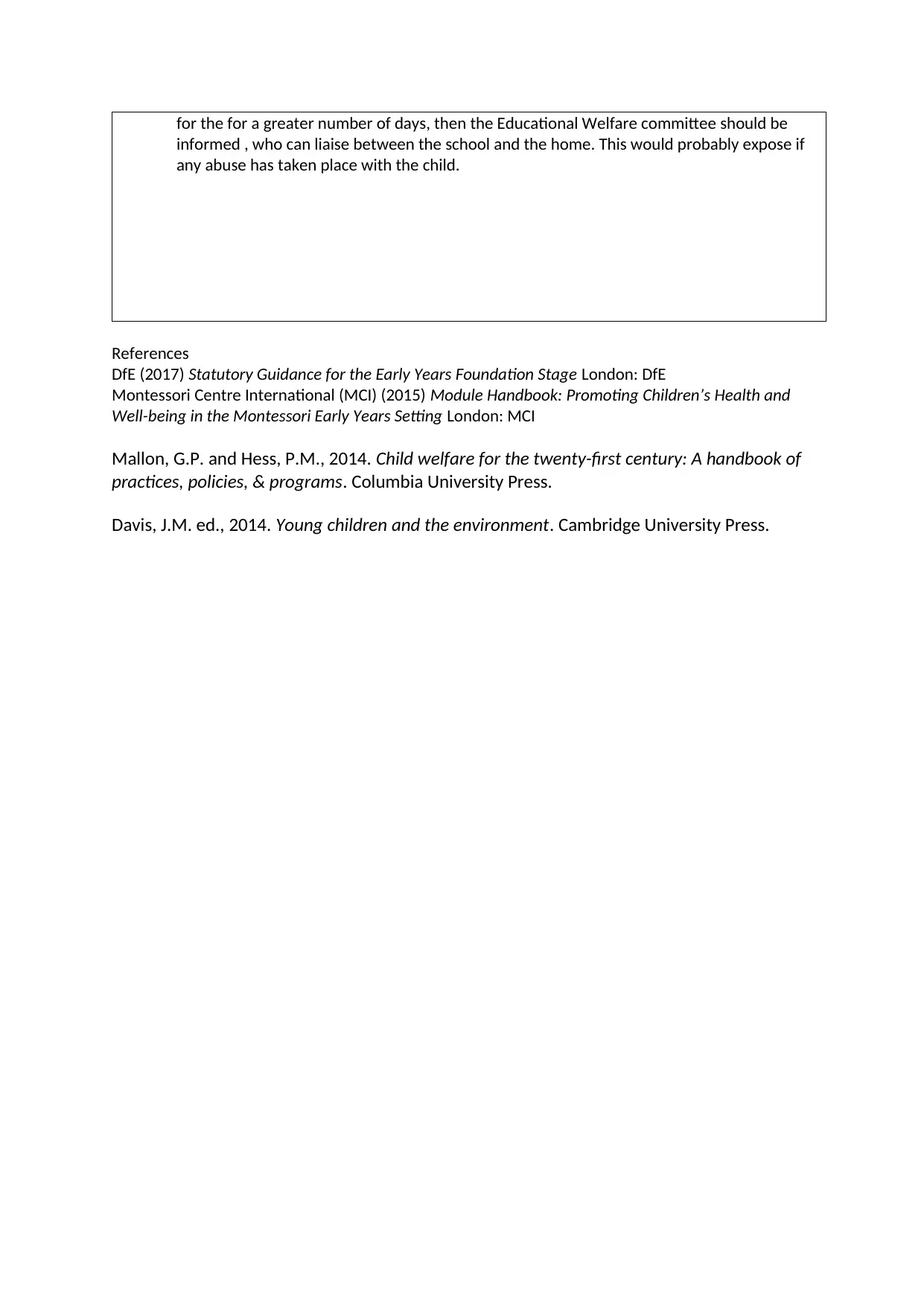Montessori Practitioner: Welfare and Safety Responsibilities Analysis
VerifiedAdded on 2022/08/25
|3
|1336
|63
Report
AI Summary
This report analyzes the multifaceted responsibilities of a Montessori early years practitioner in ensuring the welfare and safety of children within the context of a Montessori setting. It delves into key areas such as health and safety protocols, security measures, meticulous record-keeping and reporting procedures, the critical importance of confidentiality, first aid protocols, drop-off and collection procedures, and the specific role of the key person in a child's development. The analysis further examines safeguarding policies and procedures, emphasizing the identification of various forms of child abuse (domestic, neglect, physical, emotional, and sexual) and the appropriate actions to be taken when policies are not followed, including escalation procedures and the importance of staff training and adherence to legal guidelines. The report also covers the significance of anti-discrimination policies, attendance policies, and the role of the educational welfare committee. The report is based on the provided assignment brief and relevant sources.

Diploma in Montessori Pedagogy Level 4
Developing Own Montessori Practice in Professional Placement
Assessment Criteria
Number
Assessment criteria
On completion of this assessment you should be able to:
5.3.2 In 500-750 words :
Analyse the responsibilities of the Montessori early years practitioner in
supporting the welfare and safety of children in the context of the
Montessori early years setting.
Responsibilities of the Montessori early year’s practitioner in supporting the
welfare of children must include: health and safety, security, record keeping
and reporting, confidentiality of information, first aid procedure, drop off
and collection procedure and role of the keyperson.
The roles and responsibilities of an early years practitioner incudes encouraging the development of
children by play and teaching , creating an environment that is safe and secure, using imagination
for helping children to earn, working with the parents for supporting children. One of the important
step is to safe guard the children. It is necessary to monitor that a child is not subjected to any kind
of neglect or abuse, physical emotional or sexual abuse. In case of any suspicion, red flag should be
raised and the matter needs to be escalated to the parents, higher authority or to the organisations
working for the welfare of children (Davis 2014). An early year’s practitioner should be able to
assess the risks of the classroom environment and should take strict action if any negligence found.
Regular risk assessment should be done for preventing any injury or falls, such as the flooring,
electrical connections, presence of any sharp corners or sharp edges or the toxicities of the play
materials. An early childhood practitioners should keep a note that there is enough security present
in the premises for the safety of the student. Security should be maintained specially during any
excursions and close surveillance should be on each child between the time of the drop off and the
collection of child by their parents. This would include roll calls, with subsequent matching of the
identification card, before a student leaves or if a person is not recognised as the parent or the carer
of the child, then the child should not be allowed to leave. It is necessary to ensure that the CCTV
cameras and the classroom and the premises are in a perfect working conditions (Davis 2014).
Special attention needs to be given to the fire evacuation process and it should be hassle free to
ensure a smooth passage. It is necessary to ensure that each and every staffs have a recent DBS
screening.
An early childhood practitioners will act promptly, if a child feels unwell during the school hours. In
case of infectious diseases the child should be immediately shifted to a rest room under the
surveillance of a student nurse, away from the other students present in the classroom. An early
childhood practitioner should ensure that the stock of medicines are full and the first aid box
contain ample medicines to provide first aids to the students. However, the first aid box needs to be
kept out of the reach of the children (Davis 2014).
An early childhood practitioners will keep a record of the observations in order to understand the
development process of the children, their grievances and incidents. Daily information needs to be
recorded and shared with the parents about the activities that has been carried out, the food and
the drinks, sleep and the nappy changes. Some of the other records that needs to be recorded are
the details of the maximum number of children being catered for at any time, ration of the
staff/child ratio within the service. Details of the types of services and the age ranges or the details
Developing Own Montessori Practice in Professional Placement
Assessment Criteria
Number
Assessment criteria
On completion of this assessment you should be able to:
5.3.2 In 500-750 words :
Analyse the responsibilities of the Montessori early years practitioner in
supporting the welfare and safety of children in the context of the
Montessori early years setting.
Responsibilities of the Montessori early year’s practitioner in supporting the
welfare of children must include: health and safety, security, record keeping
and reporting, confidentiality of information, first aid procedure, drop off
and collection procedure and role of the keyperson.
The roles and responsibilities of an early years practitioner incudes encouraging the development of
children by play and teaching , creating an environment that is safe and secure, using imagination
for helping children to earn, working with the parents for supporting children. One of the important
step is to safe guard the children. It is necessary to monitor that a child is not subjected to any kind
of neglect or abuse, physical emotional or sexual abuse. In case of any suspicion, red flag should be
raised and the matter needs to be escalated to the parents, higher authority or to the organisations
working for the welfare of children (Davis 2014). An early year’s practitioner should be able to
assess the risks of the classroom environment and should take strict action if any negligence found.
Regular risk assessment should be done for preventing any injury or falls, such as the flooring,
electrical connections, presence of any sharp corners or sharp edges or the toxicities of the play
materials. An early childhood practitioners should keep a note that there is enough security present
in the premises for the safety of the student. Security should be maintained specially during any
excursions and close surveillance should be on each child between the time of the drop off and the
collection of child by their parents. This would include roll calls, with subsequent matching of the
identification card, before a student leaves or if a person is not recognised as the parent or the carer
of the child, then the child should not be allowed to leave. It is necessary to ensure that the CCTV
cameras and the classroom and the premises are in a perfect working conditions (Davis 2014).
Special attention needs to be given to the fire evacuation process and it should be hassle free to
ensure a smooth passage. It is necessary to ensure that each and every staffs have a recent DBS
screening.
An early childhood practitioners will act promptly, if a child feels unwell during the school hours. In
case of infectious diseases the child should be immediately shifted to a rest room under the
surveillance of a student nurse, away from the other students present in the classroom. An early
childhood practitioner should ensure that the stock of medicines are full and the first aid box
contain ample medicines to provide first aids to the students. However, the first aid box needs to be
kept out of the reach of the children (Davis 2014).
An early childhood practitioners will keep a record of the observations in order to understand the
development process of the children, their grievances and incidents. Daily information needs to be
recorded and shared with the parents about the activities that has been carried out, the food and
the drinks, sleep and the nappy changes. Some of the other records that needs to be recorded are
the details of the maximum number of children being catered for at any time, ration of the
staff/child ratio within the service. Details of the types of services and the age ranges or the details
Paraphrase This Document
Need a fresh take? Get an instant paraphrase of this document with our AI Paraphraser

of any types of injuries and the accidents. Confidentiality of the information of each of the child
should be mentioned. No information of any child should be provided to any one without any
authorisation. Early childhood practitioners should ensure the leaving arrangements of the pupil are
safe .Children should not be allowed to leave with unknown persons. The practitioners are
responsible to educate the parents about the drop off or the collection timing.
Hence, it can be stated that the early care practitioners plays an important role in cognitive and
physical development of a child. A child missing out any of the milestones should be immediately
informed to their parents. An educator should keep a close watch as whether the child faces any
kind of neglects from the family.
5.3.3 In 300-500 words summarise your discussion with the setting Safeguarding
Officer to:
Describe safeguarding policies and procedures to protect children at risk of
abuse.
Possible types of abuse include; Domestic, Neglect, Physical, Emotional,
Sexual abuse
Focus on policies and procedures followed for all signs of abuse and consider
actions when policies and procedures are not followed.
The early childcare practitioners are responsible to work in compliance with safe guarding policies of
the organisation. In case the current safe guarding policies are not effective then the policies can be
upgraded as per the national policy guidelines. Some of the same guarding policies and the
procedures that needs to be followed are –
Safeguarding policies – The policy would ensure that the nursery have a designated senior
members for the management of the children. The staffing ratios should be as per the
national guidelines. Both the indoor and the outdoor staffing ratio should be maintained. At
the time of the induction procedure, DBS checking should be done for assessing the criminal
records. Each of the new staffs should be provided with hand book depicting all the policies
and the procedures.
Zero tolerance policy should be followed in case of any allegations of abuse against any
staffs of the nursery is found. Legal proceedings can follow. However, the member of the
staff should be suspended until the allegation has been investigated fully.
Confidentiality policy- A Montessori School should work as per the Data protection act,
ensuring that, any information about any child should not be shared to anybody without
consent from the parents.
Antidiscrimination and antiracism policy- Each and every nursery should comply with this
policy and strict action should be taken if any breaching of the policy takes place by any of
the employees. Every child should be protected them from the risk of radicalisation.
Attendance and leave policies- An organisation should have proper attendance policies. All
the parents should be made aware of the importance of regular attendance before the
admission of the children. In case a child is absent without any prior notification, the school
is liable to contact the parents for finding out the exact reason. In case a children is absent
should be mentioned. No information of any child should be provided to any one without any
authorisation. Early childhood practitioners should ensure the leaving arrangements of the pupil are
safe .Children should not be allowed to leave with unknown persons. The practitioners are
responsible to educate the parents about the drop off or the collection timing.
Hence, it can be stated that the early care practitioners plays an important role in cognitive and
physical development of a child. A child missing out any of the milestones should be immediately
informed to their parents. An educator should keep a close watch as whether the child faces any
kind of neglects from the family.
5.3.3 In 300-500 words summarise your discussion with the setting Safeguarding
Officer to:
Describe safeguarding policies and procedures to protect children at risk of
abuse.
Possible types of abuse include; Domestic, Neglect, Physical, Emotional,
Sexual abuse
Focus on policies and procedures followed for all signs of abuse and consider
actions when policies and procedures are not followed.
The early childcare practitioners are responsible to work in compliance with safe guarding policies of
the organisation. In case the current safe guarding policies are not effective then the policies can be
upgraded as per the national policy guidelines. Some of the same guarding policies and the
procedures that needs to be followed are –
Safeguarding policies – The policy would ensure that the nursery have a designated senior
members for the management of the children. The staffing ratios should be as per the
national guidelines. Both the indoor and the outdoor staffing ratio should be maintained. At
the time of the induction procedure, DBS checking should be done for assessing the criminal
records. Each of the new staffs should be provided with hand book depicting all the policies
and the procedures.
Zero tolerance policy should be followed in case of any allegations of abuse against any
staffs of the nursery is found. Legal proceedings can follow. However, the member of the
staff should be suspended until the allegation has been investigated fully.
Confidentiality policy- A Montessori School should work as per the Data protection act,
ensuring that, any information about any child should not be shared to anybody without
consent from the parents.
Antidiscrimination and antiracism policy- Each and every nursery should comply with this
policy and strict action should be taken if any breaching of the policy takes place by any of
the employees. Every child should be protected them from the risk of radicalisation.
Attendance and leave policies- An organisation should have proper attendance policies. All
the parents should be made aware of the importance of regular attendance before the
admission of the children. In case a child is absent without any prior notification, the school
is liable to contact the parents for finding out the exact reason. In case a children is absent

for the for a greater number of days, then the Educational Welfare committee should be
informed , who can liaise between the school and the home. This would probably expose if
any abuse has taken place with the child.
References
DfE (2017) Statutory Guidance for the Early Years Foundation Stage London: DfE
Montessori Centre International (MCI) (2015) Module Handbook: Promoting Children’s Health and
Well-being in the Montessori Early Years Setting London: MCI
Mallon, G.P. and Hess, P.M., 2014. Child welfare for the twenty-first century: A handbook of
practices, policies, & programs. Columbia University Press.
Davis, J.M. ed., 2014. Young children and the environment. Cambridge University Press.
informed , who can liaise between the school and the home. This would probably expose if
any abuse has taken place with the child.
References
DfE (2017) Statutory Guidance for the Early Years Foundation Stage London: DfE
Montessori Centre International (MCI) (2015) Module Handbook: Promoting Children’s Health and
Well-being in the Montessori Early Years Setting London: MCI
Mallon, G.P. and Hess, P.M., 2014. Child welfare for the twenty-first century: A handbook of
practices, policies, & programs. Columbia University Press.
Davis, J.M. ed., 2014. Young children and the environment. Cambridge University Press.
⊘ This is a preview!⊘
Do you want full access?
Subscribe today to unlock all pages.

Trusted by 1+ million students worldwide
1 out of 3
Related Documents
Your All-in-One AI-Powered Toolkit for Academic Success.
+13062052269
info@desklib.com
Available 24*7 on WhatsApp / Email
![[object Object]](/_next/static/media/star-bottom.7253800d.svg)
Unlock your academic potential
Copyright © 2020–2025 A2Z Services. All Rights Reserved. Developed and managed by ZUCOL.





